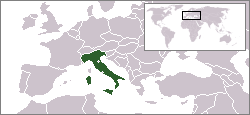| Localization | |
 | |
| Flag | |
 | |
| Basic information | |
| capital | Pomegranate |
| Government | parliamentary republic |
| Currency | euro € (EUR) |
| Area | 301,230 km2 |
| Population | 58,133,509 (est. July 2006) |
| Language | Italian (official) and dialects |
| Religion | Roman Catholics (predominant) |
| Electricity | 230V/50Hz |
| phone code | 39 |
| Internet TLD | .it |
| Time zone | UTC 1 |
THE Italy is a country of Mediterranean Europe.
Understand
Italy was the cradle of the Roman Empire and the Renaissance, which defined much of what we know as Western culture and left behind precious historical treasures of architecture and art. Even today, Italian culture - its gastronomy, cinema, design, fashion etc - exert a strong influence on the world imagination.
Italy is a peninsula located mainly in the Mediterranean Sea, bordering France, Switzerland, Austria and Slovenia in the north. The country, which is shaped like a boot, is surrounded by the Ligurian Sea, the Sardinian Sea, and the Tyrrhenian Sea in the west, the Sicilian and Ionian Sea in the south, and the Adriatic Sea in the east. Italian is the official language spoken by the majority of the population, but as you travel across the country, you will find there several distinct Italian dialects corresponding to the region you are in, Italy has a very diverse landscape, but can be described essentially as mountainous. , including the Alps and the Apennines, mountain ranges that cross the vast majority of it. Italy has two large islands as part of its country: Sardinia which is an island off the west coast of Italy and Sicily which is at the southern tip (the toe') of the boot.Italy has a population of about of 60 million people. The capital is Rome.
Regions

| Northwest (piedmont, liguria, Lombardy and Aosta Valley) |
| North East (Emilia-Romagna, Friuli-Venice Julia, Trentino-Alto Adige and Veneto) |
| center (lazio, Abruzzo, march, tuscany and umbria) |
| South (Puglia, Basilicata, Calabria, Campania and Molise) |
| Sicilia |
| sardinia |
Cities
Other destinations
To arrive
Brazilians do not need a visa to stay for up to 3 months.
By airplane
Flights leaving cities in the Brazil normally arrive at the airports of Pomegranate Leonardo da Vinci/Fiumicino and Ciampino; the airports of Milan (Malpensa and Linate) are also of considerable importance. bologna, Naples, Venice, step and Turin have international airports.
Of boat
port of Civitavecchia
By car
It is possible to reach Italy by car from any European country, through its neighbors, such as France, Switzerland and Austria. The roads in Europe are excellent, both in terms of conservation and signage.
Circular
By airplane
The main international airport is Leonardo Da Vinci/Fiumicino, on the outskirts of Pomegranate, where there is a railway station that connects the airport to the rest of the country with trains. Milan, Turin they are also important airports. Be careful with Fiumicino airport. Cases of violations and theft of luggage items are recurrent. The theft of perfumes, glasses, clothes and branded objects is common. Padlocks are often broken. It is recommended to use baggage without zipper or packaging.
Of boat
By car
Italian roads are modern and well maintained. The highways are the fastest and charge tolls (most even accept credit cards).
The speed limits are as follows:
- 130km/h on highways (autostrade)
- 110km/h on highways (superstrade)
- 90km/h on the roads (strade statali, proviciali)
- 50km/h in cities
There is speed control on both highways and common roads.
The minimum age to drive in Italy is 18 years old.
Most Italian cars have a gearshift and diesel engine (diesel, more economical) or gasoline (Super 95, common, or Super 98)
The highways (Autostrade) are fast but have tolls, some very expensive. An alternative is to use regional highways that follow the same routes as highways passing through cities, which makes the route a little longer but much more attractive.
All highways have speed controls (Autovelox, Tutor) in the vicinity of cities, so it is very important to pay attention to signs.
By bus (bus)
By train (train)
On any train journey, remember to validate your ticket on the yellow or orange composteur at the platform entrance before boarding. Traveling with an unvalidated ticket is punishable by a fine.
Speak
O Italian, in its various dialects, is spoken throughout the country. THE German is used in parts of the Trentino-Alto Adige region, as well as the rogue. O French it is spoken by a small French-speaking minority in Valle d'Aosta and Slovenian is used by a minority in the Trieste-Gorizia area.
O English it is commonly used for communication with tourists who do not understand Italian.
Look

Knife
Buy
- Via del Corso in Rome
- Via Montenapoleone in Milano
- Via Condotti in Rome
drink and go out
sleep
Learn
Work
Safety
Italy is not a very dangerous place, but it is advisable to take some precautions, such as being careful with pickpockets on public transport and Rome's tourist attractions. When traveling around the country, keep an eye on your luggage, especially on night trains - cases of theft are rare but they do occur.
Possessing and using narcotics, including marijuana, is a crime.
In case of emergency, call toll free at 112 - 113; firefighters: 115.
Health
In case of emergency, call the number 118 from any telephone, the call is free.
respect
Despite being very nice when they want to, Italians are thick by nature and have no patience with tourists. Of course, there are exceptions. Don't be alarmed if you think you're witnessing an argument in the middle of the street and only see two Italian friends meeting.
Stay in touch
| This article is outlined and need more content. It already follows a suitable model but does not contain enough information. Plunge forward and help it grow ! |

